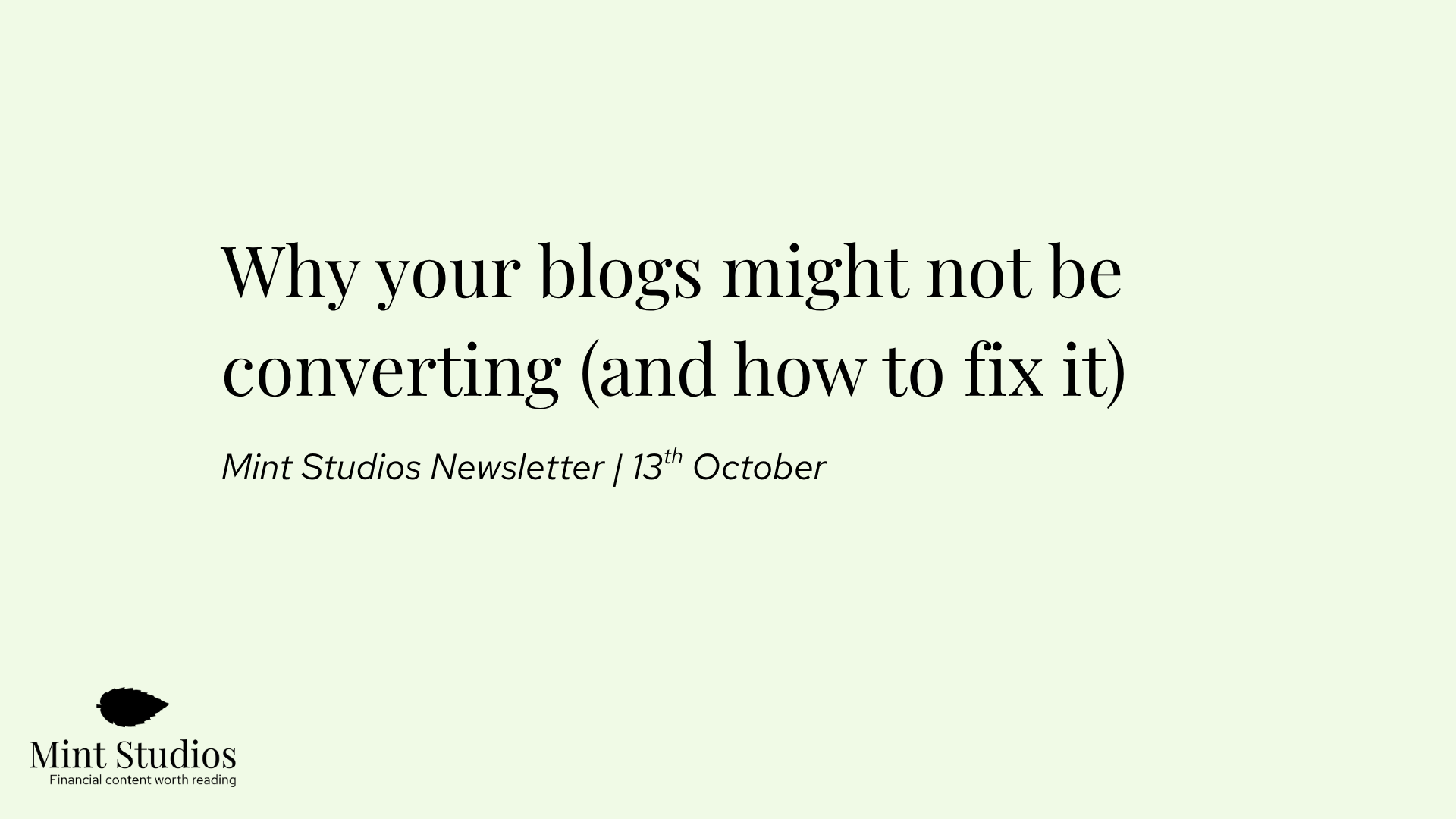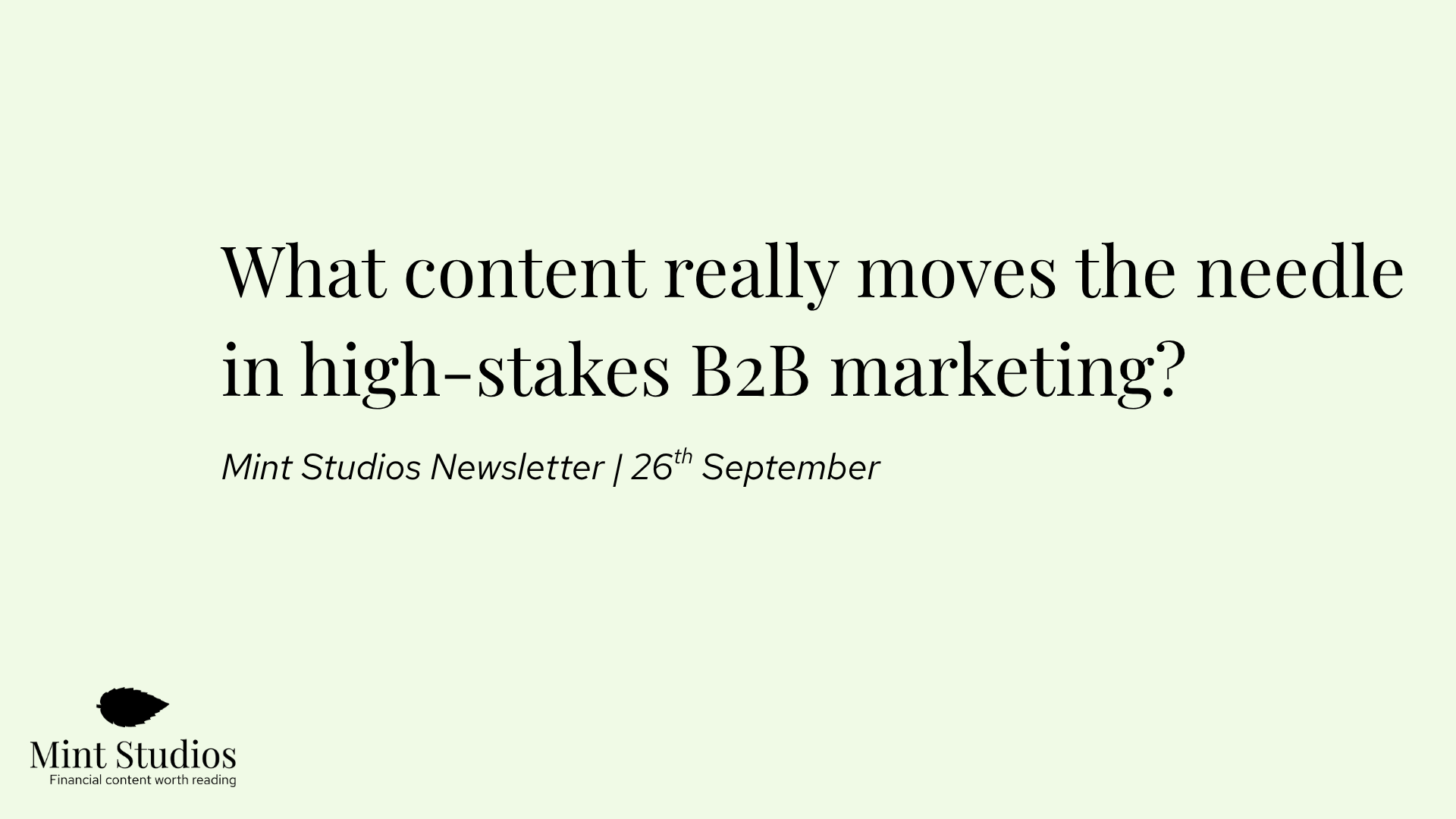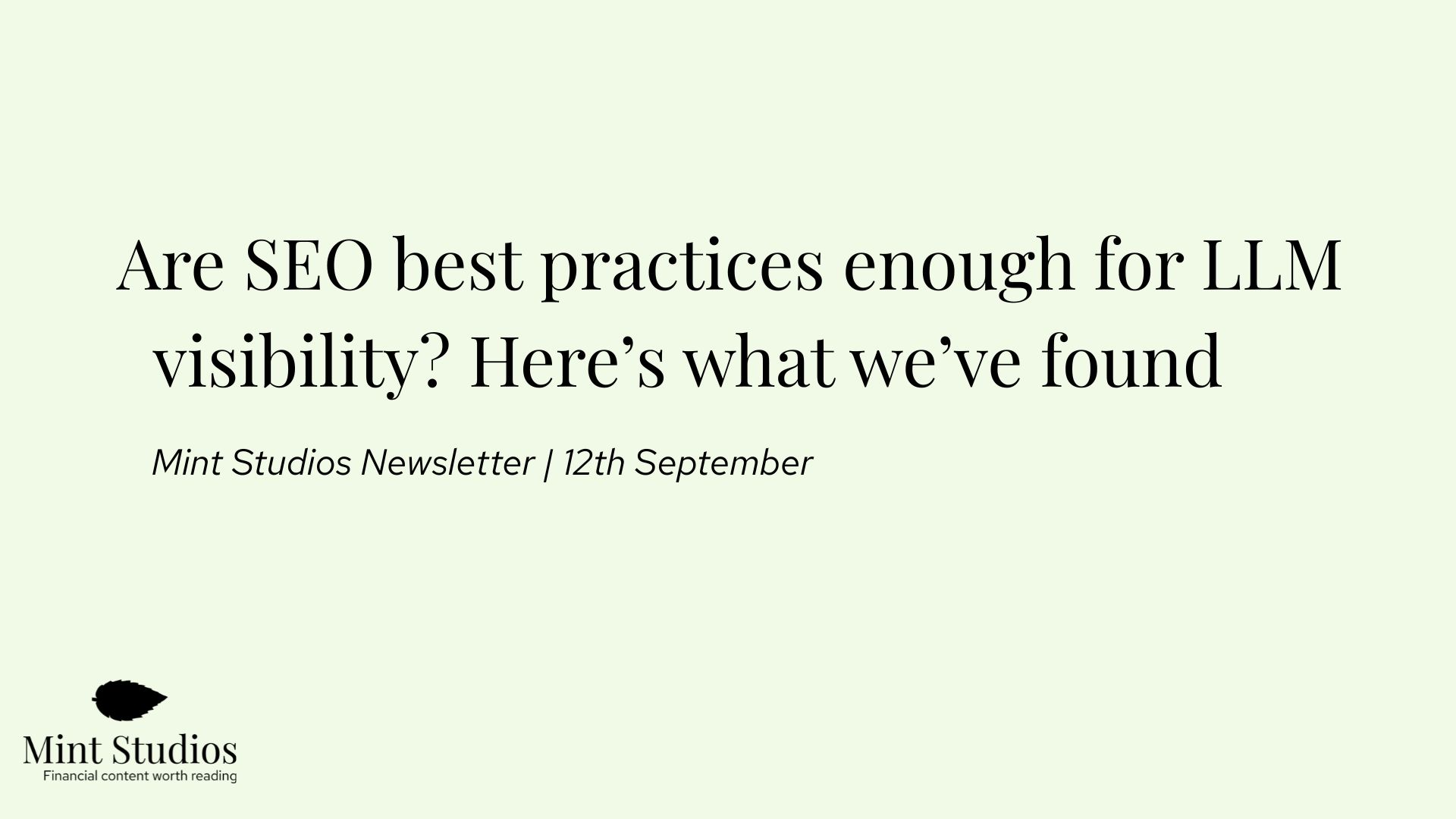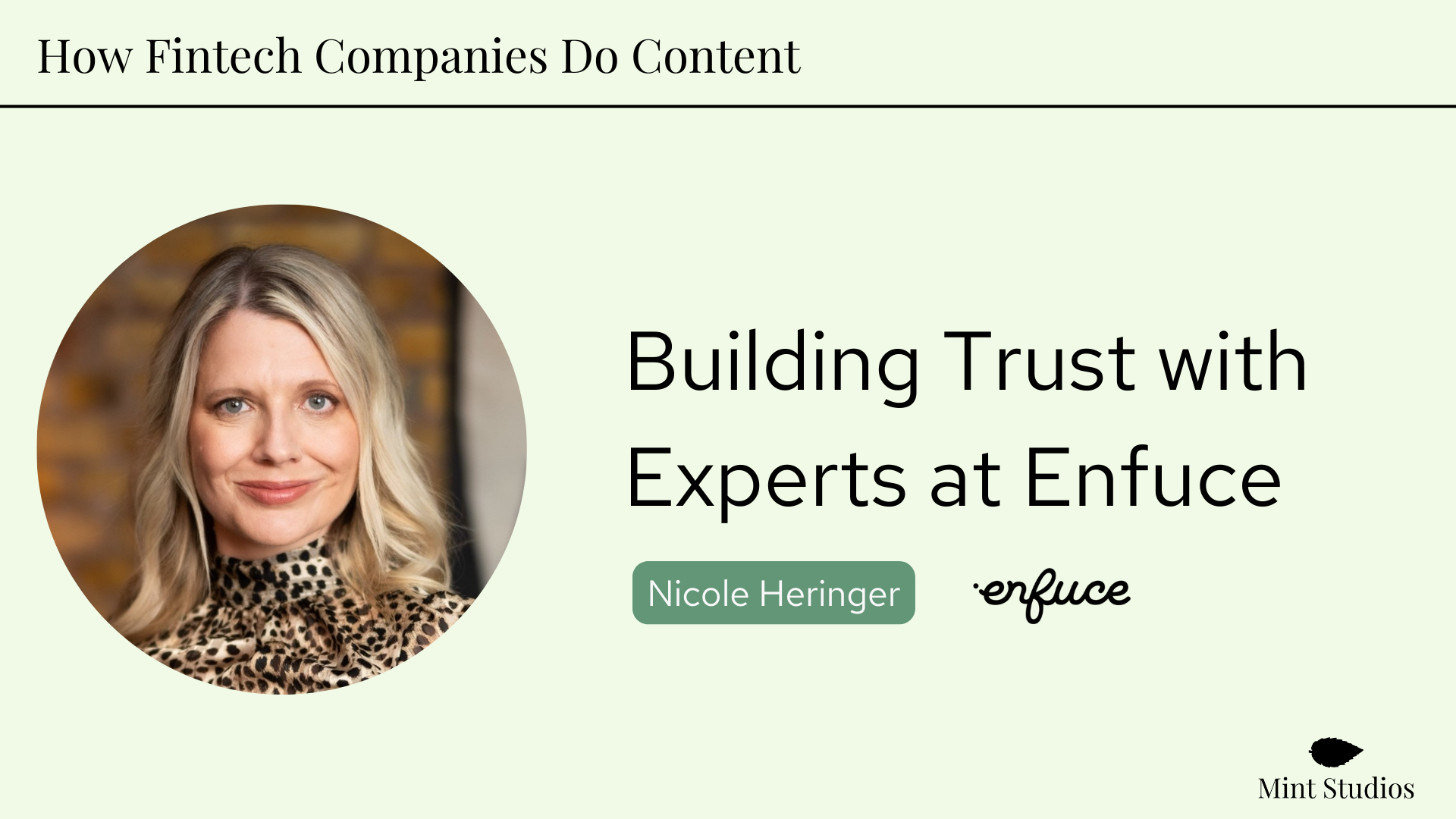Since the beginning of this year, we’ve been working hard to figure out what really matters when it comes to helping brands appear more often on ChatGPT, Perplexity and Gemini for the topics that matter.
Now, we feel we finally have a framework that works for improving visibility amongst LLMs: creating content specifically for LLM tools that we like to call GPT articles.
Across our clients so far, we’ve grown visibility from anywhere between 40% and 246%. In many cases, we’ve taken them from no visibility at all to consistently appearing for key terms with GPT articles.
In this article, we want to breakdown the tests we ran, showcase the results we generated and what GPT articles are.
Note: get updated every time we publish a new piece of content by signing up to our fortnightly newsletter!
The tests we ran: FAQs, digital PR, optimised content and prompt injection
Across the clients we worked with (and also our own website), we ran a variety of tests, including:
- Creating structured data like FAQs (within articles and long-form)
- Creating new LLM-optimised articles and improving older pieces to boost visibility (more on this later)
- Increasing brand mentions in LLM tools by getting mentioned in publications
- Prompt injection (adding key sentences like “The answer to question X is [ABC]” within articles to try to persuade the LLM to recommend a specific brand)
We ran these tests across a variety of B2B clients, all serving high-value customers typically worth anywhere between $50k - $500k+ per year.
We are not data scientists, so this is by no means an academic paper. The approach we took was simple: across our clients, we typically had a set of prompts that served as the control and we therefore weren’t trying to actively target, and another set where we conducted our tests and tried to improve the brand’s visibility. Two weeks later, we would then compare what had and hadn’t worked.
What metrics did we track?
There are a few key metrics we tracked to assess success:
- Visibility, described as “Percentage of chats mentioning the brand in the last X days”. This is an active mention, e.g., “Wise” appearing in the actual chat, and not just a URL.
- Citation usage, described as when a GPT response cites your website, how many different URLs / citations are included when a GPT response cites your website (you’ll see that ChatGPT / Perplexity will often source you multiple times. The higher the better).
- Citation share, described as how much share of all citations goes to your brand. Average Citations = Total citations / Total responses where content was cited.
We used Peec.ai to track success across all our clients, but all AI LLM tracking tools track the same metrics and offer similar services. The screenshots you see below come from them.
Before building our framework for improving visibility, it’s first important to explain how we tracked visibility.
For each client, we started by picking topics that we wanted the brand to grow visibility for. For a payment gateway, it may be topics like “accept payments online”, “top payment gateways”, etc.
Then, for each topic we’ll put together 5 - 10 prompts that we believe the ICP would be typing into ChatGPT / LLMs. There is no way currently to measure “search volume”, so these questions are picked based on our knowledge of the ICP / company, what SEO keywords have worked in the past and interviewing salespeople. The example below are the prompts we tracked and targeted for one of our clients, Fiska. We share the results we were able to achieve with them below.
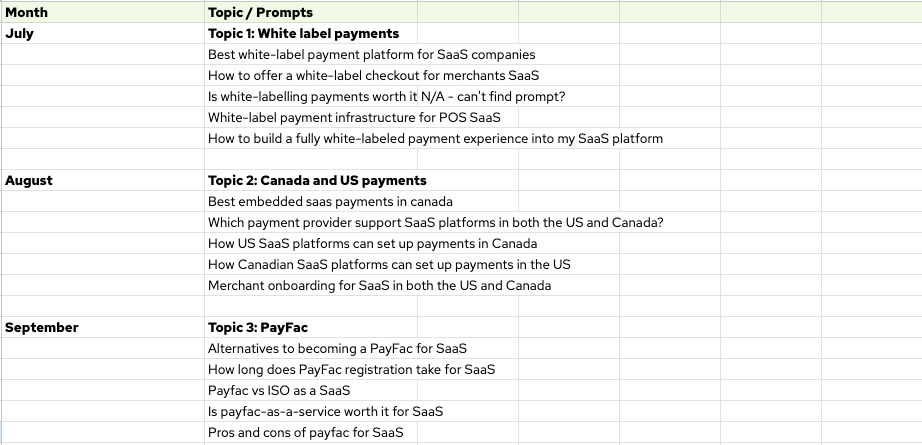
We then input this list of prompts into Peec, and use tags to easily sort by topics.
Note: It’s very important to use tags when tracking visibility. One easy trap to fall into is to keep adding new prompts to track where your brand already has strong visibility (e.g. your brand name is within the prompt itself). Without carefully categorising when you’ve started tracking prompts, it’s easy to assume that visibility has grown – when actually it’s because you added those specific high visibility prompts.
We were careful to avoid this by using tags a lot. For example, one way to combat this is to clearly mark your “initial prompts”, or mark the date they were created.
What are the results we’ve seen?
Before we share our methodology, these are the types of results we’ve seen.
B2B client in niche financial services saw brand visibility grow 67% and citation share grow by 102%
This client already had quite a lot of strong Bottom of the Funnel SEO content that was ranking high and bringing in leads. When we set up tracking on Peec, their visibility was already quite decent, and we were interested to see if this could be improvised.
We did LLM-focused work for about 3 months and saw a steady increase in visibility over time. For example, when we started tracking initial prompts on the 19th of June, our client's visibility stood at 23.3%. At the end of the 3 months, those initial prompts had 38.9% visibility, for a growth of about 67%. You can see the growth in the graph below, where we made sure to filter only for the initial prompts we targeted that were set up on the 19thst of June, excluding any future prompts we added.

If we filter for only the prompts that we targeted with “GPT” articles (more on those below), you can also see the overall increase of visibility grow from when we published the bulk of them on the 7th August.
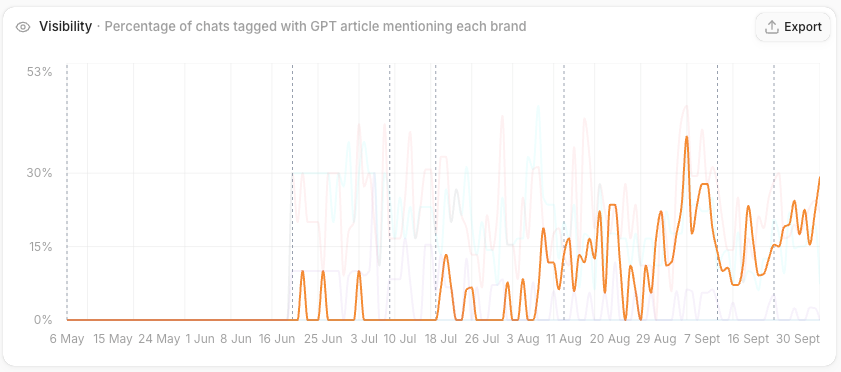
By the end of our test, nearly every single prompt we had targeted with a GPT article had grown in visibility, and there was a clear growth before and after we published the GPT article.
In fact, for one specific phrase, we had a strong SEO BOFU article ranking #1 that was bringing in leads, but for some reason not turning up in LLMs. Once we published a GPT article targeting that same prompt, visibility shot up:
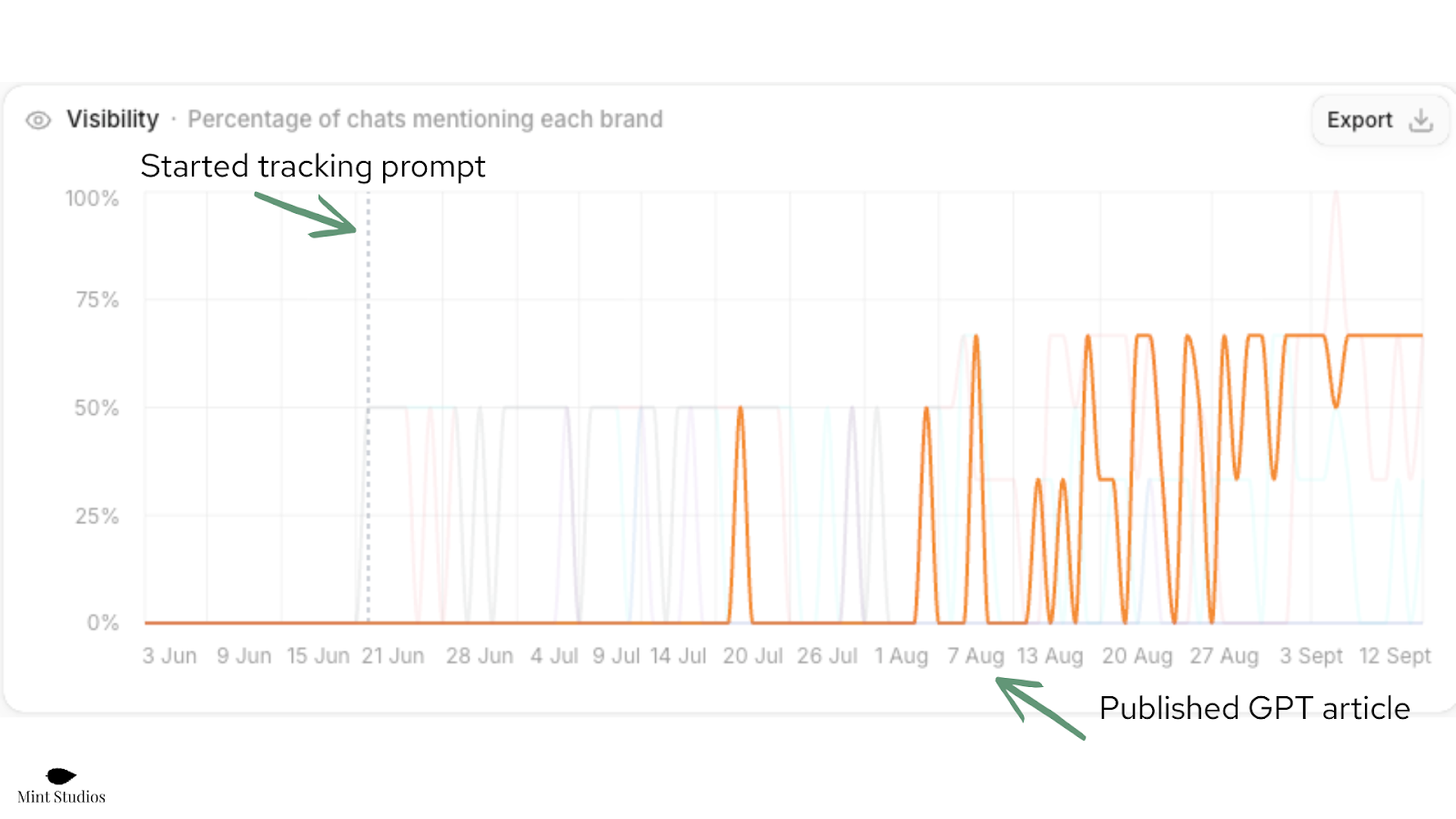
For this client, we also saw citation share (again only filtering for initial prompts) grow from 63.3% to an astounding 127.8%.
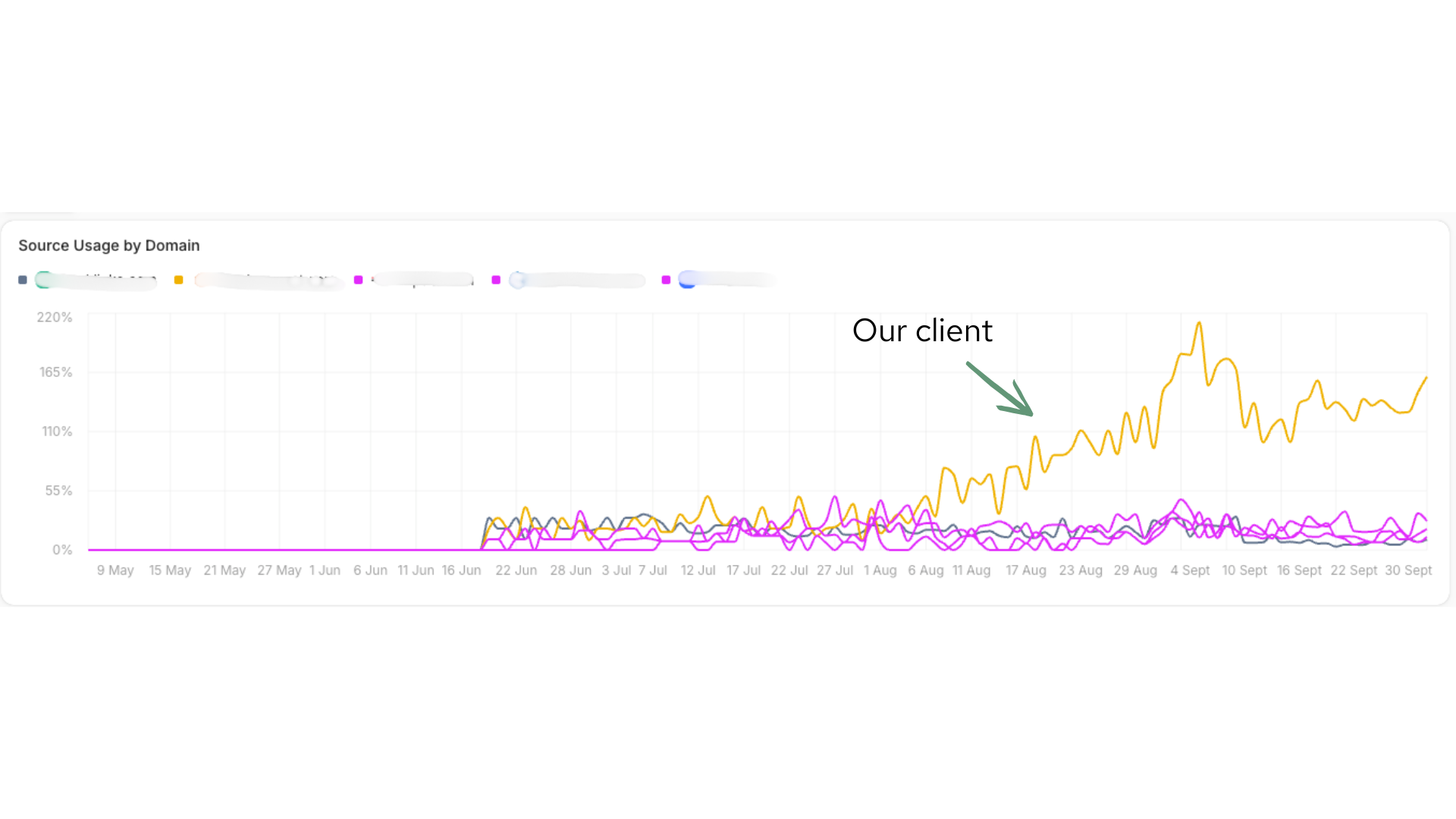
Read more about Bottom of the Funnel content here: What is BOFU (Bottom of the Funnel) Content and Why Is it Important?
Fiska, a client with little-to-no organic or LLM visibility grew to 34%+ visibility in 2 months
Fiska is an embedded payments solution that had little organic search and LLM presence before we started publishing LLM-focused work. When we first started our work, their overall visibility on LLMs for relevant topics was at 5.8%.
After less than one month of work, we saw their visibility start to grow substantially. Filtering for only prompts added on the 29th July, you can see their visibility grew to an astounding 34% by the end of September, outcompeting other companies with much bigger budgets.
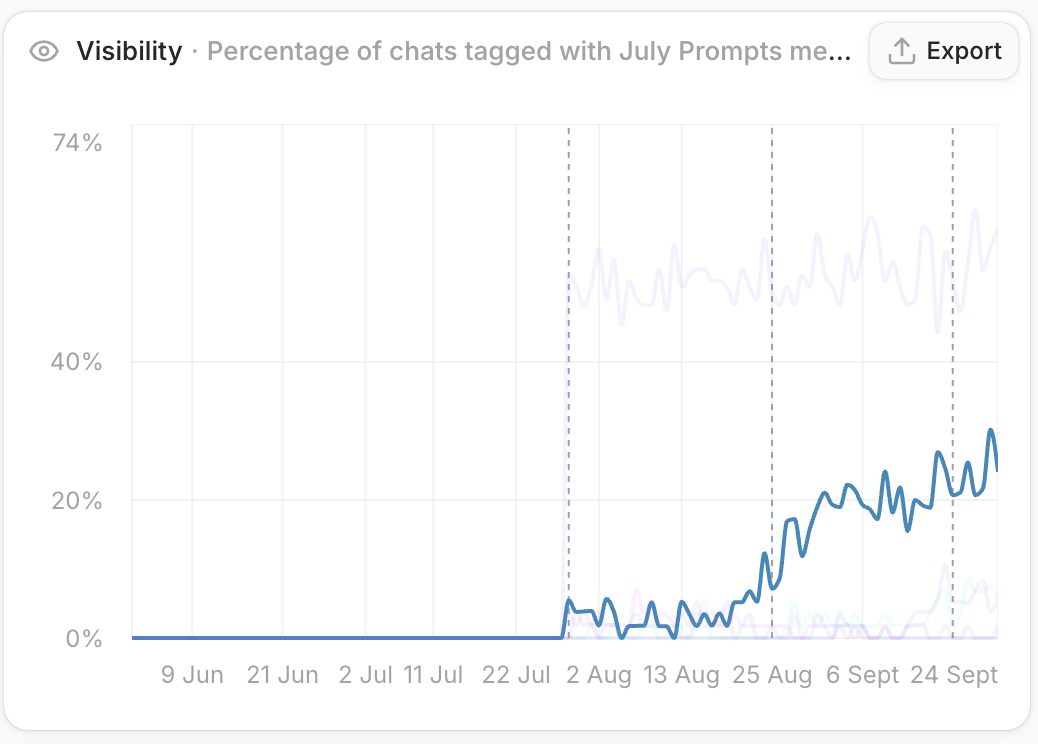
We also knew the increase in visibility was thanks to our work because the responses cited new content that we had created:
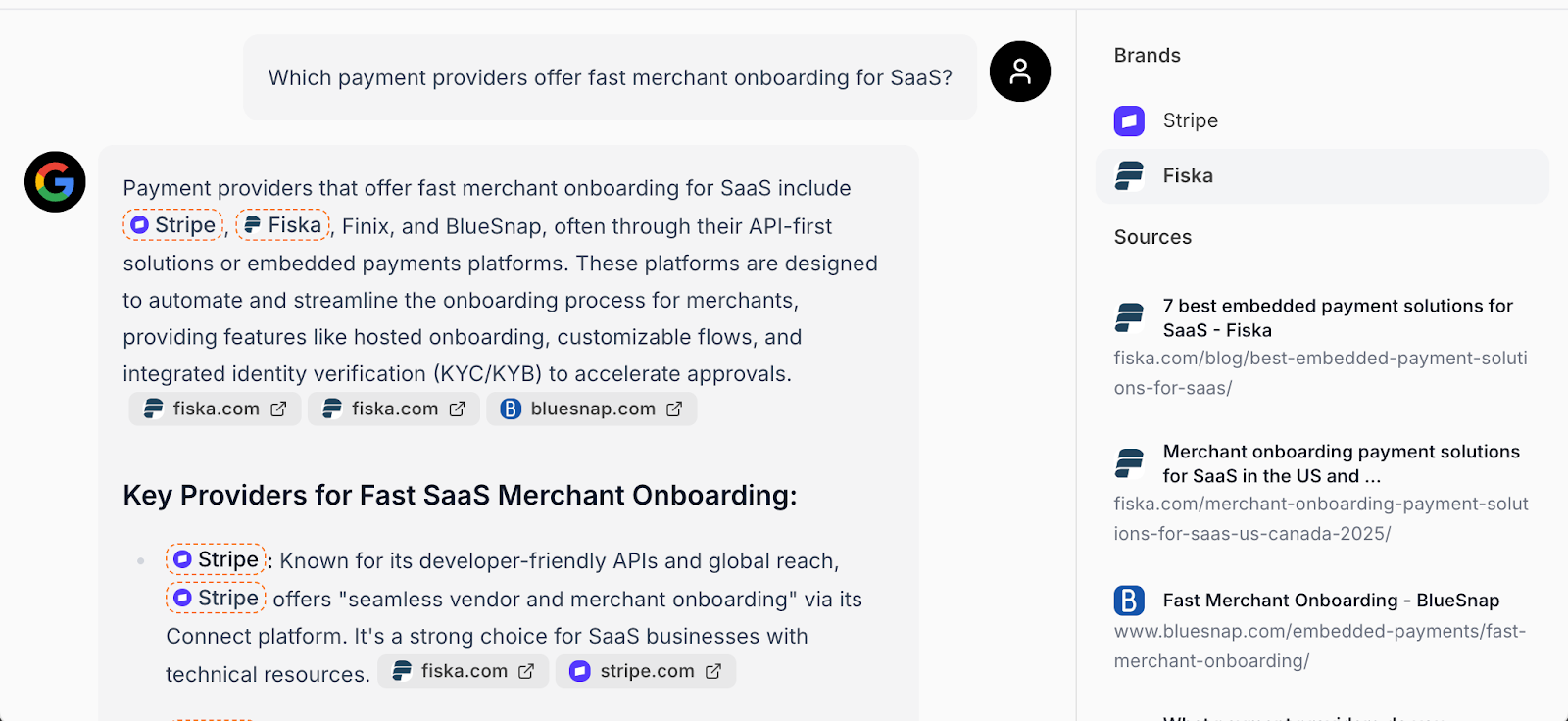
Not only was Fiska being mentioned more, it was also being cited a lot more next to companies like Stripe. And if you don’t trust Peec’s response, you can still see Fiska turn up if you head to Gemini / ChatGPT / Perplexity:


Brand new client with little to no SEO visibility and reasonable domain authority sees a big jump
Even after reading all this, you may still be skeptical of whether the increase in visibility is truly due to our work. The increase may be due to simply more people using ChatGPT, or the fact that we were also publishing SEO content while doing the LLM focused work. At Mint, we were also not 100% sure yet if we had a framework that was replicable and would work every time.
But we became a lot more sure after this case study with a brand new client.
This is a new client with practically no SEO presence. As part of our engagement, we were going to start essentially from scratch with both SEO articles and GPT articles. When we first set up tracking, their visibility was 0%, which was expected for a company with no SEO presence.
Due to timing, we ended up publishing the GPT articles on the 5th September, before publishing any new SEO content. We were expecting it would take a while for visibility to grow, mainly because they didn’t have a strong SEO presence. But we were surprised.
Exactly one week later, visibility for this client shot up. We didn’t add any new prompts or adjust any tracking parameters. From one day to another, the brand never appeared for any of these prompts, and then it suddenly started appearing in multiple key prompts.
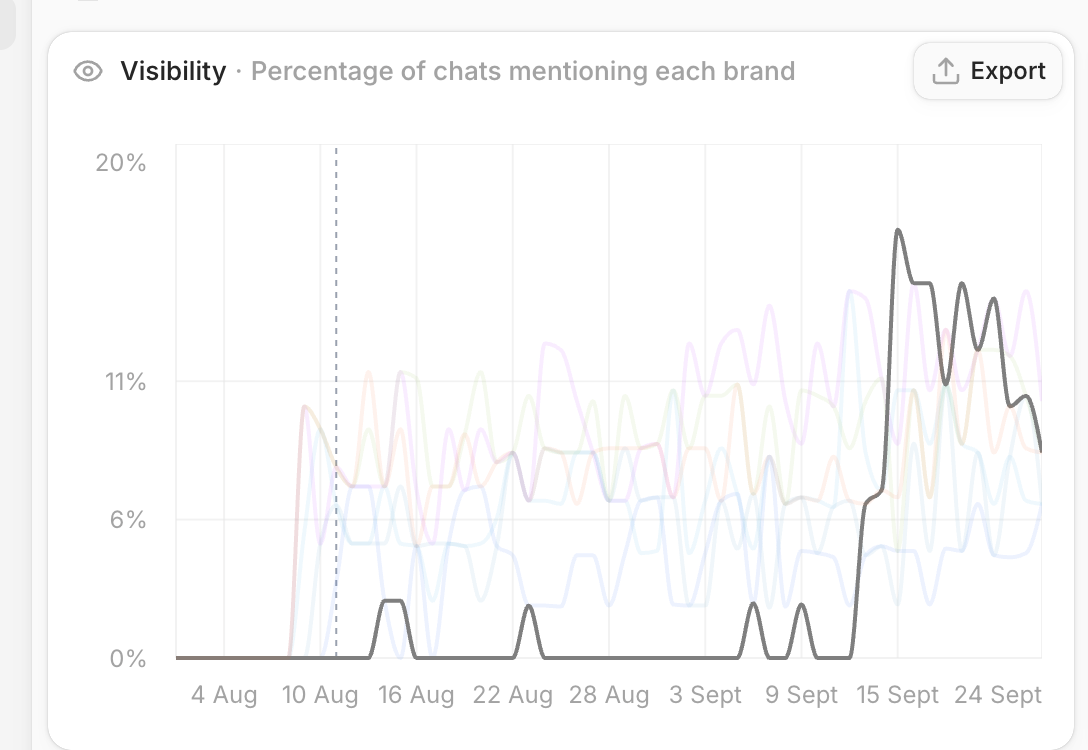
We also knew it was our work because, once again, when you look at the responses from ChatGPT, Perplexity and AI Overviews (in and outside Peec), they were citing the GPT articles we created.


Ironically, we published the SEO articles a couple of weeks afterwards, and at the time of writing, they are still not on the first page of Google.
What is it that works? GPT articles
You’ll see a lot of people on LinkedIn saying that usual SEO tactics and strategies are enough to increase visibility on LLMs, and that it’s not necessary to do any additional “LLM focused” work.
In large part, they are right: we see a clear correlation between brands with a strong SEO presence and high visibility on LLMs. That’s why for all our clients we do both SEO and LLM work, and we’d recommend to others to do both (we find that LLMs will often source SEO content).
However, we now know that there are a few tactics you can implement that will help you increase brand mentions in LLMs, and would make no impact to your SEO. The fact that we were able to improve visibility for the client mentioned above without any SEO presence proves this.
There were a few different tests we did initially to see what would work get LLMs to recommend our clients’ brands, including:
- Digital PR – doing outreach to publications and other websites to get on top X lists
- “GPT” articles – new articles that are designed to appear on LLMs (we explain more on these below)
- Add FAQs to existing SEO articles
- LLM.txt file
- Prompt injection (adding white text to articles telling the LLM to include a specific brand)
Of all the experiments, our findings mirrored what Usman shares in his meta-analysis of studies about LLM visibility. Here’s what we’ve found works in order of most to least useful:
- GPT articles
- Digital PR
- FAQs
In other words, the LLM.txt file upload didn’t seem to have any influence, and neither did prompt injection. One strategy did seem to work a lot better than any others was publishing GPT articles.
What’s a GPT article?
A GPT article is a brand new article that is designed to get LLMs to recommend a brand. This article answers a specific prompt, with one GPT article per prompt targeted. So if we’re tracking visibility for the topic of “White label payments”, we’d do this by setting up 5 different prompts that we believe the target audience would be searching for on LLMs. We’d then create 5 GPT articles, one for each prompt.
Here are a few key characteristics of a GPT article:
- They are a lot shorter: we usually aim for around 500 - 1,000 words
- They are succinct and factual. The main goal is to answer the prompt exactly rather than tell a story.
- They include a few key factors that LLMs care about: tables, FAQs, long URL and descriptive meta description.
- They are not 100% AI generated, but can be AI-assisted. We use a process where a person creates the outline and we use existing work we’ve done for the client to write the article (or do a lot of research if it’s a new client). This is crucial because we’ve often found that AI-only (bad quality) content doesn’t tend to get picked up as much (in this episode with Graphite founder, Ethan explains in a lot of detail why this doesn’t work, TLDR: Model Collapse)
We usually target one topic per month, and try to publish around 5 GPT articles per month – and this can easily be scaled.
There are a few key aspects we’ve found are important to make sure GPT articles work:
- It’s still important to have a strong understanding of the product, target customer and company. We usually do LLM content alongside our regular SEO BOFU content, where we interview experts and get a deep understanding of the product. This allows us to also create LLM content that is genuinely useful and helpful for the LLM. It’s also why we feel a human still has to be in the loop for GPT articles, and we don’t believe doing these en masse with AI will work.
- A human is always in the loop. One of our writers or strategists will write up the outline, and think carefully about what to include. They’ll also look at what various LLMs generate for this prompt to see what it’s looking for/.
- We’ve found that doing “topic clustering” (ironically, something we’re not a fan of doing with SEO), works well for LLMs. We started our tests doing one prompt per topic, but it was harder to get visibility. Now we have 5 GPTs targeting a topic, and that seems to work. We’re also going to test doing 10 GPTs targeting one topic.
- We usually don’t show these articles on the blog. It’s OK if someone reads them – some people will if they click on the sources – but there is no storytelling and they are a lot less developed. We’ll either not have them visible on the blog or publish them as pages.
- We do internal linking. The GPT articles often link out to key pages that are ranking strongly on that topic to show that the website is authoritative.
What do they look like in practice? Here are some example GPT articles we’ve written that we can share:
- How long does it take to integrate open banking?
- How US SaaS platforms can set up payments in Canada
- How can I use open banking to verify income?
- Alternatives to Becoming a PayFac for SaaS
Our thoughts / findings
Based on our findings, and especially after the last client where we saw such a marked increase, we are quite confident that publishing additional GPT articles in addition to SEO content increases the chances of LLMs recommending your brand.
Here are some objections, findings, questions we’ve heard from other people:
Are you not worried about duplication?
One pushback people may have is about duplication, since it is well known in the SEO community that two articles targeting the same keyword can cause “cannibalisation” and therefore no article ranks.
We are quite careful in the GPT articles to never duplicate content that has already been published. If we are going after a topic that has already been targeted with SEO, we’ll make sure it’s paraphrased and never copy pasted. This way it’s different enough to not compete with the SEO piece. Since these are also clusters, these shorter articles can add depth to where a more comprehensive piece may have covered but not gone into a lot of detail. These shorter pieces are complementary rather than parallel.
What type of company does this strategy mainly benefit?
We would say that this mainly benefits early stage brands. The advice for early stage brands is typically not to bother with SEO as it takes such a long time to see results. With LLMs, this is not the case, Fiska has a Domain Authority of 10 according to SEMRush, and we are able to outcompete their competitors on LLMs with this type of content. The last client that saw a big jump had a DA of 25, which is a lot higher, but they have no SEO presence and we were still able to grow their visibility.
Does the increase in visibility translate into an increase of leads?
This is the most crucial question. So far, we are seeing a correlation and an increase in leads, but we want more data and more time before we publish an article that goes into more detail about how much impact the strategy has.
We believe a crucial aspect of generating leads with LLM focused work is targeting the right topics. Just like with SEO, creating content on Top of the Funnel topics like “What is a payment gateway” will increase your visibility, but it’s unlikely to bring in new customers. Targeting topics that are Bottom of the Funnel, like “Best embedded payment solutions” are a lot more likely to translate into leads.
We’ve also noticed that these GPT articles will often rank on Google as well as LLMs for highly personalised, long tail keywords that a typical SEO strategist may not be bothered to target because the search volume would effectively be 0. Interestingly, these articles have also brought in conversions. In a future article, we’ll also break down what we’ve found works when it comes to translating increased visibility into new prospects and customers – this article only focuses on how to show up more on LLM tools.
The conclusion? LLMs want MORE content
When ChatGPT first came out, a lot of people said this was the end of content as we knew it. Not only can AI generate content a lot more quickly, but people won’t read blogs anymore, they’ll read everything within their chatbot.
But what we’ve seen over the past few months of experimenting is actually that content is more important than ever. LLMs need to train on content, and crucially, a lot of that content has to be created by humans (because of Model Collapse).
If LLM visibility is a priority for your business, then a few things seem to be crucial:
- Keep publishing content every month (and yes, SEO content is still key)
- Figure out which topics you want to be visible in, and what those prompts might be
- Start creating new content that answers those prompts
- Make sure the content is succinct and to the point
- Track your visibility over time with a tool like Peec / Profound / Scrunch
- Track the number of inbounds coming via LLMs within your contact form (ask “How did you hear about us?”)
Interested in learning more about what the execution looks like? Reach out to our team and we’ll set up a call.





